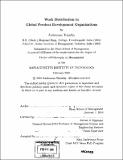| dc.contributor.advisor | Steven D. Eppinger. | en_US |
| dc.contributor.author | Tripathy, Anshuman | en_US |
| dc.contributor.other | Sloan School of Management. | en_US |
| dc.date.accessioned | 2010-08-31T14:30:55Z | |
| dc.date.available | 2010-08-31T14:30:55Z | |
| dc.date.copyright | 2010 | en_US |
| dc.date.issued | 2010 | en_US |
| dc.identifier.uri | http://hdl.handle.net/1721.1/57770 | |
| dc.description | Thesis (Ph. D.)--Massachusetts Institute of Technology, Sloan School of Management, 2010. | en_US |
| dc.description | Cataloged from PDF version of thesis. | en_US |
| dc.description | Includes bibliographical references (p. 147-155). | en_US |
| dc.description.abstract | The evolution of the internet, digital design tools, and more importantly, increasing access to global markets and workforce, has increased the interest of firms in offshoring their engineering and product development activities. However, there exist challenges in coordinating and collaborating across time zones, cultures, geographical locations, and organizations. These challenges are magnified in the case of firms engaged in the design and development of complex engineered products. Our field study of the global engineering efforts of five firms showed that offshoring success is largely affected by the choice of the offshoring content, the architecture of the firm's products, and the organization choices of the respective firms. This led us to frame our research questions as: How does a firm optimally structure the global work distribution, over time, of its product development organization? How does the firm's architecture affect these work distribution decisions? Arguing based on existing literature in operations management, product development, and organizational economics, we identify coordination effort required between locations as a key contributing factor towards the performance of global product development organizations. We segregate the time required to complete a product development task between work time and coordination time, and define the index of modularity for offshoring as the ratio of the work time to the sum of work time and coordination time. | en_US |
| dc.description.abstract | (cont.) We incorporate this factor to develop a recursive equation model that identifies the global structure (work distribution) of a product development organization. We apply our model to structure (optimize) the global product development organization in an industrial setting (with the aim of minimizing costs). We use the design structure matrix (DSM) to map the current process flow. This DSM helps us identify the organization architecture that we can utilize in our optimization model. Our optimization results, based on detailed modeling of coordination costs, show significant cost savings through a re-structured PD organization. Subsequent analysis of our results shows that while offshoring based on modularity is generally right, it is not the whole answer as there exists a trade-off between the efficiency of performing specific PD tasks at the offshore location and the modularity of the task. Besides relative cost rates and modularity, the optimal organization structure is also affected by the relative efficiencies in performing the product development tasks across locations, leading to additional research questions: How does the task completion time change (efficiency differences) when a PD task is transferred to an offshore product development center? How are the firm's prioritization and distribution of efforts towards the offshored PD tasks affected by the various factors that affect the task completion time? | en_US |
| dc.description.abstract | (cont.) To understand these efficiency differences and address the above questions, we develop and analyze a stylized model (two tasks, two locations, two time periods) for a firm seeking to establish a product development center at an offshore location to benefit from cost savings. Our key results show that (a) firms should determine their offshore content to benefit from the existing knowledge base created by the prior offshored content and to create a knowledge base from which subsequent offshoring can benefit (indicating path dependent offshoring) rather than offshoring solely based on modularity; (b) efforts supporting offshoring should prioritize the coordination challenges between tasks at different locations before those between tasks at the offshore location; and (c) in an environment of high volatility of external factors, efforts should be prioritized to enhance the work time and coordination time efficiencies in the first (earliest) period. | en_US |
| dc.description.statementofresponsibility | by Anshuman Tripathy. | en_US |
| dc.format.extent | 155 p. | en_US |
| dc.language.iso | eng | en_US |
| dc.publisher | Massachusetts Institute of Technology | en_US |
| dc.rights | M.I.T. theses are protected by
copyright. They may be viewed from this source for any purpose, but
reproduction or distribution in any format is prohibited without written
permission. See provided URL for inquiries about permission. | en_US |
| dc.rights.uri | http://dspace.mit.edu/handle/1721.1/7582 | en_US |
| dc.subject | Sloan School of Management. | en_US |
| dc.title | Work distribution in global product development organizations | en_US |
| dc.type | Thesis | en_US |
| dc.description.degree | Ph.D. | en_US |
| dc.contributor.department | Sloan School of Management | |
| dc.identifier.oclc | 625106043 | en_US |
